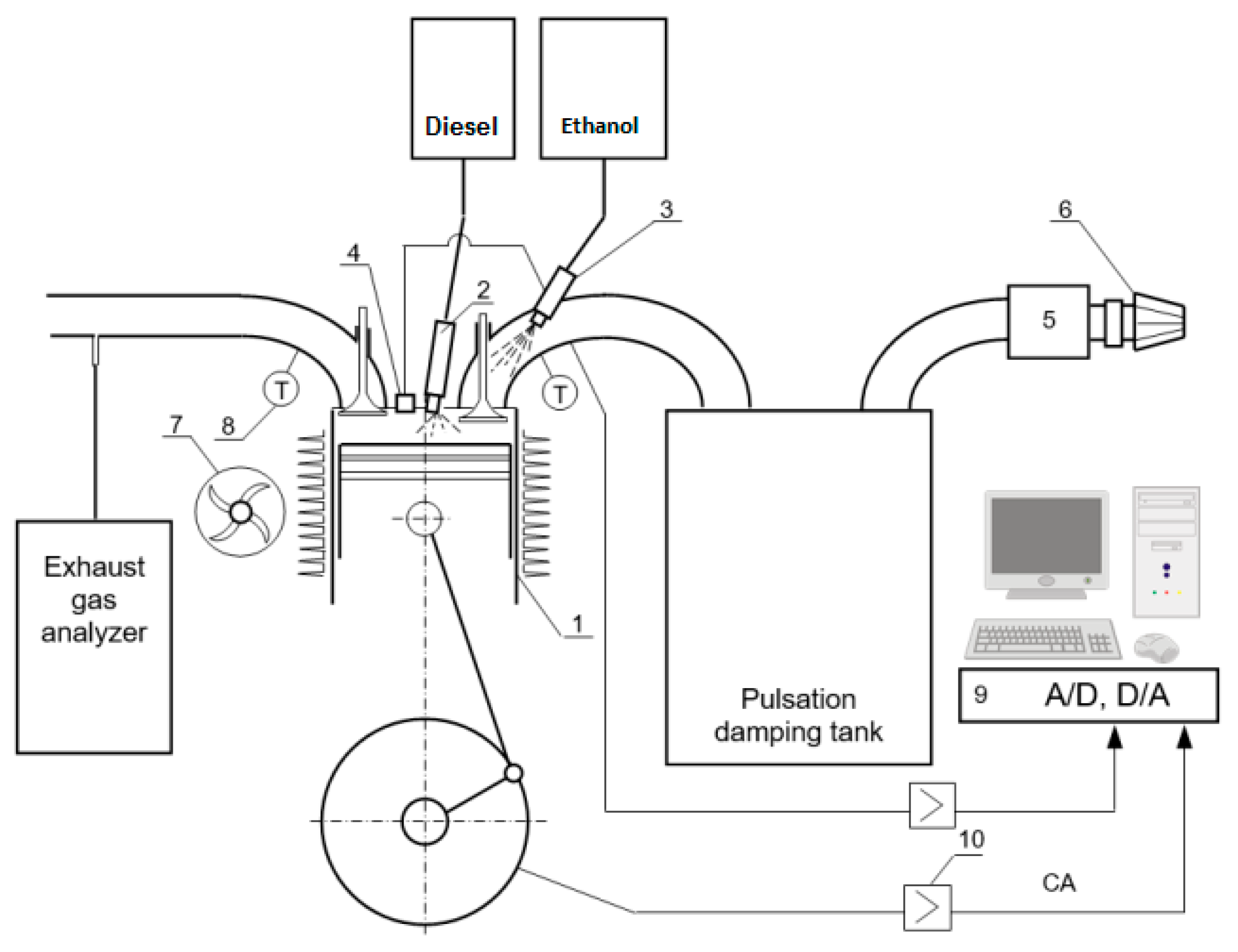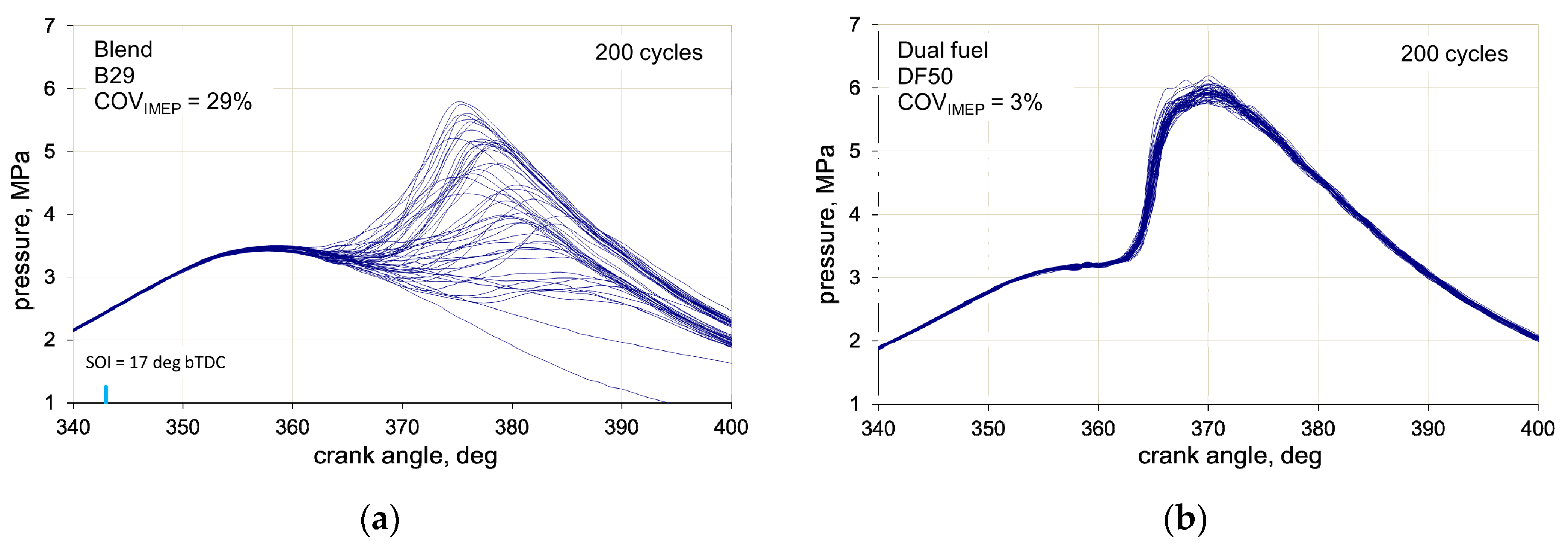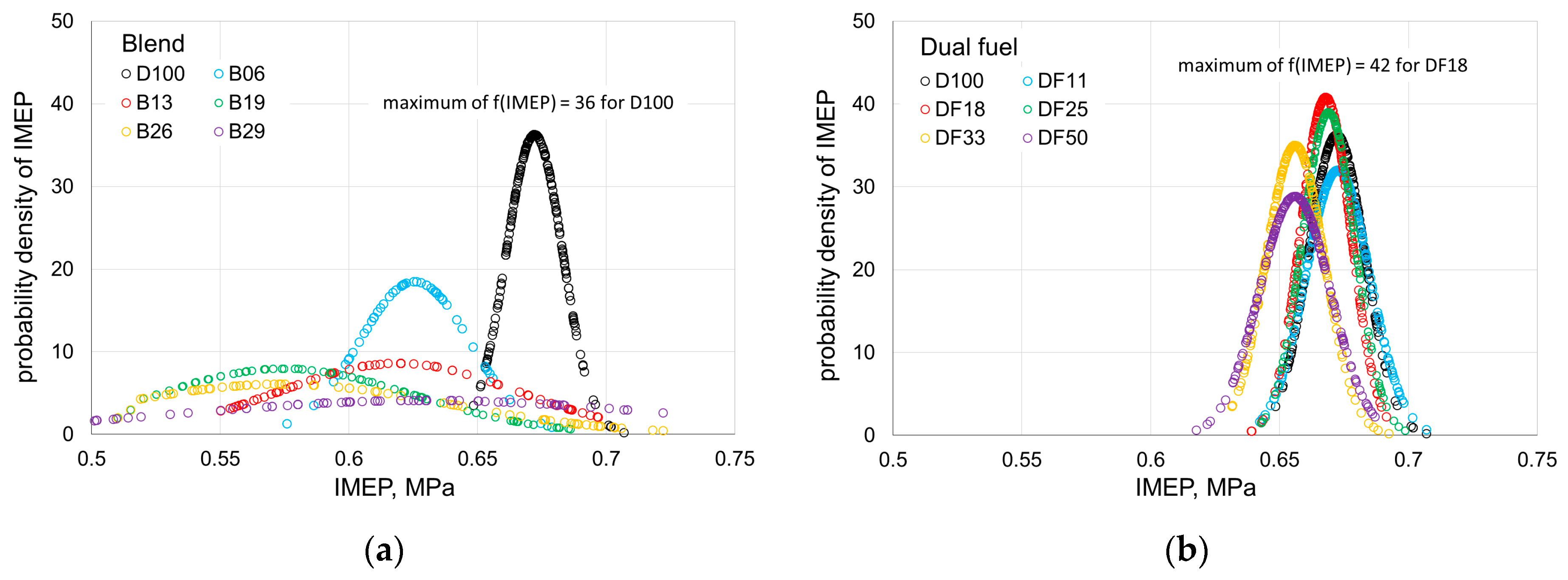Comparative Analysis of Combustion Stability of Diesel/Ethanol Utilization by Blend and Dual Fuel
Abstract
1. Introduction
2. Materials and Methods
2.1. Experimental Test Stand
- -
- piezoelectric pressure transducer, Kistler 6061 SN 298131, sensitivity: ±0.5%,
- -
- charge amplifier, Kistler 5011B, the linearity of FS < ±0.05%,
- -
- data acquisition module, Measurement Computing USB-1608HS—16 bits resolution, sampling frequency 20 kHz,
- -
- the CA encoder, resolution 360 pulses/rev, software for digital recording and analysis of the frequency signals [23].
2.2. Calculation Methodology
3. Results Analysis
4. Conclusions
- (i)
- With the increase in the ethanol energetic fraction in the blend, up to nearly 20%, the peak pressure increases. The highest pressure was obtained for an ethanol fraction of 19%, equal to 6.12 MPa at 8 deg after TDC. Regarding DF, all values of the peak pressures were higher than those for the diesel engine.
- (ii)
- In case of dual fuel mode, the maximum increase in ignition delay was 7 deg of CA (for 50% ethanol fraction), but in case of blend combustion, this increase was 11 deg of CA (for 29% ethanol fraction).
- (iii)
- Crossing 19% ethanol energetic fraction in the blend, the COVIMEP exceeded 5%; in case of dual fuel technology, the COV of IMEP was below 3% for all ethanol fractions.
- (iv)
- Up to 19% ethanol fraction, the spread of ID was in the range of 2 deg of CA; for the blend combustion, SID started to increase after exciding 19% ethanol fraction.
- (v)
- Ethanol fraction in dual fuel technology increases the repeatability of the end of the combustion, but in case of blend combustion, the increase in ethanol causes an increase in the SEC parameter.
Author Contributions
Funding
Conflicts of Interest
Abbreviations
| IMEP | indicated mean effective pressure, MPa |
| HRR | heat release rate, J/degree |
| COVIMEP | coefficient of variation of indicated mean effective pressure, % |
| Qnorm | normalized heat release |
| σIMEP | standard deviation of indicated mean effective pressure, MPa |
| LHV | lower heating value, MJ/kg |
| BSEC | brake specific energy consumption, MJ/kWh |
| DF | dual-fuel mode |
| ID | ignition delay, degrees |
| CD | combustion duration, degrees |
| SID | spread of ignition delay |
| SEC | spread of end of combustion |
| f(IMEP) | probability density of indicated mean effective pressure |
| CI | compression ignition engine |
| TDC | top dead center |
| CA | crank angle |
| SOI | start of injection |
| NOx | nitrogen oxides |
| THC | total hydrocarbons |
| CO | carbon monoxide |
| PM | particulate matter |
| φ | crank angle, degrees |
References
- Szabados, G.; Bereczky, Á.; Ajtai, T.; Bozóki, Z. Evaluation analysis of particulate relevant emission of a diesel engine running on fossil diesel and different biofuels. Energy 2018, 161, 1139–1153. [Google Scholar] [CrossRef]
- Merkisz, J.; Fuć, P.; Lijewski, P.; Pielecha, J. Actual emissions from urban Buses powered with diesel and gas engines. Transp. Res. Procedia 2016, 14, 3070–3078. [Google Scholar] [CrossRef]
- Merkisz, J.; Waligórski, M. Strategy of the combustion process diagnosis in direct injection engines. Procedia Eng. 2014, 96, 294–301. [Google Scholar] [CrossRef][Green Version]
- Damanik, N.; Ong, H.Ch.; Mofijur, M.; Tong, Ch.W.; Silitonga, A.S.; Shamsuddin, A.H.; Sebayang, A.H.; Mahlia, T.M.I.; Wang, C.-T.; Jang, J.-H. The performance and exhaust emissions of a diesel engine fuelled with Calophyllum inophyllum—Palm biodiesel. Processes 2019, 7, 597. [Google Scholar] [CrossRef]
- Rimkus, A.; Žaglinskis, J.; Stravinskas, S.; Rapalis, P.; Matijošius, J.; Bereczky, A. Research on the combustion, energy and emission parameters of various concentration blends of hydrotreated vegetable oil biofuel and diesel fuel in a compression-ignition engine. Energies 2019, 12, 2978. [Google Scholar] [CrossRef]
- Jamrozik, A.; Tutak, W.; Grab-Rogaliński, K. An experimental study on the performance and emission of the diesel/CNG dual-fuel combustion mode in a stationary CI engine. Energies 2019, 12, 3857. [Google Scholar] [CrossRef]
- Lee, J.; Lee, S.; Lee, S. Experimental investigation on the performance and emissions characteristics of ethanol/diesel dual-fuel combustion. Fuel 2018, 220, 72–79. [Google Scholar] [CrossRef]
- Tutak, W.; Lukács, K.; Szwaja, S.; Bereczky, Á. Alcohol–diesel fuel combustion in the compression ignition engine. Fuel 2015, 154, 196–206. [Google Scholar] [CrossRef]
- Tutak, W.; Jamrozik, A.; Bereczky, Á.; Lukács, K. Effects of injection timing of diesel fuel on performance and emission of dual fuel diesel engine powered by diesel/E85 fuels. Transport 2018, 33, 633–646. [Google Scholar] [CrossRef]
- Jamrozik, A.; Tutak, W.; Gnatowska, R.; Nowak, Ł. Comparative analysis of the combustion stability of diesel-methanol and diesel-ethanol in a dual fuel engine. Energies 2019, 12, 971. [Google Scholar] [CrossRef]
- Jamrozik, A.; Tutak, W.; Gruca, M.; Pyrc, M. Performance, emission and combustion characteristics of CI dual fuel engine powered by diesel/ethanol and diesel/gasoline fuels. J. Mech. Sci. Technol. 2018, 32, 2947–2957. [Google Scholar] [CrossRef]
- Stelmasiak, Z.; Matyjasik, M. Exhaust emissions of dual fuel self-ignition engine with divided initial dose. Combust. Engines 2013, 154, 944–952. [Google Scholar]
- Nowak, Ł.; Tutak, W. Combustion stability of dual fuel engine powered by diesel-ethanol fuels. Combust. Engines 2019, 178, 155–161. [Google Scholar]
- Jamrozik, A.; Tutak, W.; Pyrc, M.; Sobiepański, M. Experimental investigations on combustion, performance and emission characteristics of stationary CI engine fuelled with diesel-methanol and biodiesel-methanol blends. Environ. Prog. Sustain. Energy 2017, 36, 1151–1163. [Google Scholar] [CrossRef]
- Kuszewski, H. Experimental investigation of the autoignition properties of ethanol–biodiesel fuel blends. Fuel 2019, 235, 1301–1308. [Google Scholar] [CrossRef]
- Kuszewski, H.; Jaworski, A.; Ustrzycki, A.; Lejda, K.; Balawender, K.; Woś, P. Use of the constant volume combustion chamber to examine the properties of autoignition and derived cetane number of mixtures of diesel fuel and ethanol. Fuel 2017, 200, 564–575. [Google Scholar] [CrossRef]
- Kuszewski, H. Experimental investigation of the effect of ambient gas temperature on the autoignition properties of ethanol–diesel fuel blends. Fuel 2018, 214, 26–38. [Google Scholar] [CrossRef]
- Kuszewski, H. Experimental study of the autoignition properties of n-butanol–diesel fuel blends at various ambient gas temperatures. Fuel 2019, 235, 1316–1326. [Google Scholar] [CrossRef]
- Tutak, W.; Jamrozik, A.; Gnatowska, R. Combustion of different reactivity fuel mixture in a dual fuel engine. Therm. Sci. 2018, 22, 1191–1203. [Google Scholar] [CrossRef]
- Paul, A.; Panua, R.; Debroy, D. An experimental study of combustion, performance, exergy and emission characteristics of a CI engine fueled by diesel-ethanol-biodiesel blends. Energy 2017, 141, 839–852. [Google Scholar] [CrossRef]
- Jamrozik, A.; Tutak, W.; Pyrc, M.; Sobiepański, M. Effect of diesel/biodiesel/ethanol blend on combustion, performance and emissions characteristics on a direct injection diesel engine. Therm. Sci. 2017, 21, 591–604. [Google Scholar] [CrossRef]
- Tutak, W.; Jamrozik, A.; Pyrc, M.; Sobiepański, M. A comparative study of co-combustion process of diesel-ethanol and biodiesel-ethanol blends in the direct injection diesel engine. Appl. Therm. Eng. 2017, 117, 155–163. [Google Scholar] [CrossRef]
- Gruca, M. Software for acquisition of internal combustion engine data. J. Kones 2004, 11, 205–211. [Google Scholar]
- Tutak, W.; Jamrozik, A. Characteristics of the flow field in the combustion chamber of the internal combustion test engine. Chem. Process. Eng. 2011, 32, 203–214. [Google Scholar] [CrossRef]
- Heywood, J.B. Internal Combustion Engine Fundamentals, 2nd ed.; McGraw-Hill Education: New York, NY, USA, 2018. [Google Scholar]







| Parameter | Value | Unit |
|---|---|---|
| Number of cylinders | 1 | - |
| Displacement volume | 0.573 | dm3 |
| Bore | 90 | cm |
| Stroke | 90 | cm |
| Compression ratio | 17:1 | - |
| Crankshaft rotational speed | 1500 | rpm |
| Injection pressure | 21 | MPa |
| Injection timing | 17 | deg bTDC |
| Maximum rated power | 7.4 | kW |
| Properties | Diesel Fuel | Ethanol Fuel |
|---|---|---|
| Molecular formula | C14H30 | C2H5OH |
| Molecular weight | 170–198 | 46 |
| Surface tension (mN/m @ 15 °C) | 26.9 | 21.78 |
| Cetane number | 51 | 8 |
| Lower heating value, (MJ/kg) | 41.7 | 26.9 |
| Density at 20 °C, (kg/m3) | 856 | 789 |
| Viscosity at 25 °C, (mPa s) | 2.8 | 1.078 |
| Heat of evaporation, (kJ/kg) | 260 | 918 |
| Stoichiometric air fuel ratio | 14.7 | 9.06 |
| Autoignition temperature, (°C) | 300–340 | 698 |
| Flash point, (°C) | 78 | 16.6 |
| Hydrogen content, wt% | 13 | 13 |
| Carbon content, wt% | 87 | 52.2 |
| Oxygen content, wt% | 0 | 34.8 |
© 2019 by the authors. Licensee MDPI, Basel, Switzerland. This article is an open access article distributed under the terms and conditions of the Creative Commons Attribution (CC BY) license (http://creativecommons.org/licenses/by/4.0/).
Share and Cite
Tutak, W.; Jamrozik, A. Comparative Analysis of Combustion Stability of Diesel/Ethanol Utilization by Blend and Dual Fuel. Processes 2019, 7, 946. https://doi.org/10.3390/pr7120946
Tutak W, Jamrozik A. Comparative Analysis of Combustion Stability of Diesel/Ethanol Utilization by Blend and Dual Fuel. Processes. 2019; 7(12):946. https://doi.org/10.3390/pr7120946
Chicago/Turabian StyleTutak, Wojciech, and Arkadiusz Jamrozik. 2019. "Comparative Analysis of Combustion Stability of Diesel/Ethanol Utilization by Blend and Dual Fuel" Processes 7, no. 12: 946. https://doi.org/10.3390/pr7120946
APA StyleTutak, W., & Jamrozik, A. (2019). Comparative Analysis of Combustion Stability of Diesel/Ethanol Utilization by Blend and Dual Fuel. Processes, 7(12), 946. https://doi.org/10.3390/pr7120946





